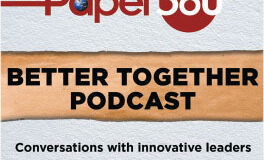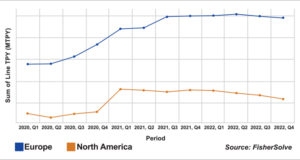Corrugated manufacturing is a crucial industry, with a growing demand for sustainable packaging solutions. Digitalization is vital for this sector, since producers face various challenges that can impact the efficiency and profitability of their operations.
According to the consulting firm Fisher International, demand in the containerboard sector took the industry by storm in 2020 and 2021. The global containerboard market is approximately 235 million metric tons; this represents around 38 percent of the global pulp and paper industry. Several factors have fueled the need for mills to continually increase their containerboard capacity. These included everything from increased sustainability initiatives to a booming e-commerce sector thanks to pandemic lockdowns.
However, in 2022, the European and North American corrugated box sectors experienced a decline in demand and capacity for the first time ever in Europe and for the first time since 2012 in North America. Dennis Colley, president of the Fiber Box Association, reports that “After two record years for box shipments, the slowdown in the US economy has impacted demand for boxes.” Adds Fisher International analyst Stuart Sharp: “The crazy boom we saw in the sector in 2020 and 2021 is not something we’re likely to see in the short term.” Overall, however, he remains confident: “The demand and need for containerboard isn’t going anywhere.”
SUPPLY CHAIN WORRIES
Despite the positive order situation, many paper and paperboard producers are struggling to achieve acceptable profit margins. The question that keeps manufacturers awake at night isn’t whether orders will continue to come in, but whether they can continue to deliver—and whether production is financially sustainable when cost trends deviate from cost estimates.
Raw materials like pulp or paper can be hard to procure. The demand for sustainable sourcing practices and the increasing use of alternative materials in many sectors frequently lead to price fluctuations and limited availability of raw materials. A report by Forest Stewardship Council (FSC) states that the demand for sustainable paper and cardboard products is expected to reach US$200 billion by 2025. This directly affects the bottom line of any corrugated manufacturer.
Currently, raw material prices are sinking—after skyrocketing in the last two years. Managing costs, however, remains vital. In many cases, about 75 -90 percent of corrugated box production cost is attributable to the cost of paper.
Additionally, not only the price, but the availability of raw materials is an issue. In some cases, up to 85 percent of the raw material comes from discarded fiber collected from local authorities, but a decline in recycling rates has squeezed supply. In the UK, for example, in 2020 household recycling rates fell 1.2 percent, to just under 10 million tons.
Many corrugated companies rely on local suppliers, but unexpected shortages of important materials or spare parts can put the brakes on a local supplier’s production as well. Plus, cardboard production involves multiple stages, and this complexity can lead to inefficiencies such as delayed shipments or inventory overstocks.
Environmental concerns add to the complexity: While cardboard-based products improve the global ecological footprints (for instance, when they replace plastic packaging), the production of paper and cardboard contributes to environmental pollution, and companies are under pressure to reduce their own carbon footprint. According to the World Watch Institute, the paper industry accounts for 25 percent of global forest harvesting and is responsible for 4 percent of the world’s carbon dioxide emissions.
OPTIMIZATION IS KEY
To tackle these challenges, companies can adopt IT-based planning and IT-optimized production methods. This approach can streamline supply chain processes and improve decision-making through real-time data analysis. By incorporating advanced planning tools, such as demand forecasting and optimization algorithms, companies can improve their demand-supply balancing and reduce waste.
Planning and optimization tools calculate in advance what boards need to be produced where and when and specify how the board needs to be trimmed to produce the desired end products. A trim optimization tool such as T.CON’s Trim Suite produces cutting plans with one click—taking into account that corrugated board typically contains three or more layers of paper, each with different grades, thicknesses, lengths and grammages. The software also helps to reduce machine set-up times and the need to reconfigure machines. Excel is no match for that kind of planning.
Another key building block toward a robust and fully digitized production system for corrugated companies is a Manufacturing Execution System (MES), which can provide information about the status of production orders. The MES is the data hub linking platform data from the shop floor with data from the enterprise resource planning system, ideally fully integrated into the other components of the company’s IT. This enables the enterprise to generate an up-to-date, complete, centralized view of all data relating to the manufacturing process and compile detailed analyses of the data at any time.
The data provided by such a system can also be used to make better decisions. If recipes for different types of paper are scattered across individual computers in data formats such as Excel, or even just filed away as hard copies, it is costly and time-consuming to reschedule when key materials are unavailable. With a fully integrated IT landscape, it is easy to consider whether a particular base material can be replaced or whether it makes more sense to postpone the planned order and switch to a different product.
If a company plans to use new materials or redesign processes to be more environmentally friendly, intelligent systems can provide the necessary information. They can be redesigned in time to adapt to a new business reality.
In contrast, a patchwork of applications often makes it impossible to make the right decisions and take advantage of process improvements. Lack of integration drives up maintenance costs and reduces the budget available for value-adding digital innovation. And if a company plans to grow rapidly—as many corrugated and other packaging companies do today—the patchwork of legacy IT systems often slows things down because they are difficult to roll out to new plants or business units.
The use of Industry 4.0 technologies such as the Internet of Things (IoT) and artificial intelligence (AI) can also optimize production processes and reduce energy consumption. For example, machine learning algorithms can predict equipment failures and optimize maintenance schedules, improving uptime and reducing downtime. According to an Accenture report, Industry 4.0 technologies can reduce energy consumption in the manufacturing sector by up to 30 percent. They also need an integrated IT system as a foundation. Why? These innovative technologies need reliable data, or they cannot deliver optimal results.
By adopting IT-based planning and IT-optimized production, corrugated producers can deal with supply challenges and improve their overall performance. With the right tools and integrated technologies in place, companies can achieve more sustainable and efficient production, ultimately contributing to a greener future.
 Paper 360
Paper 360

